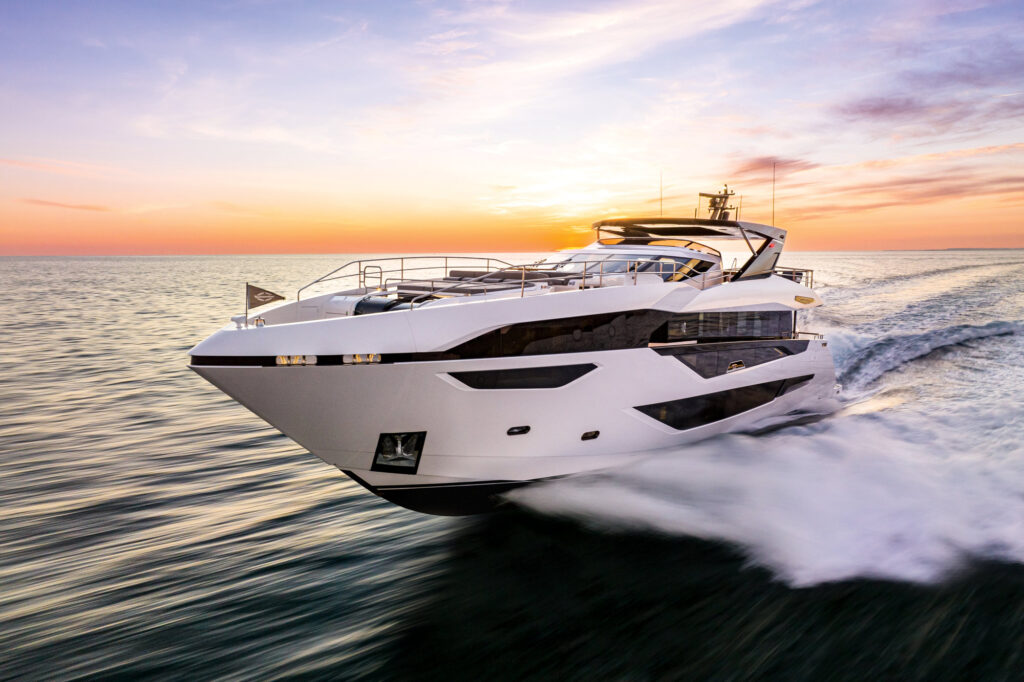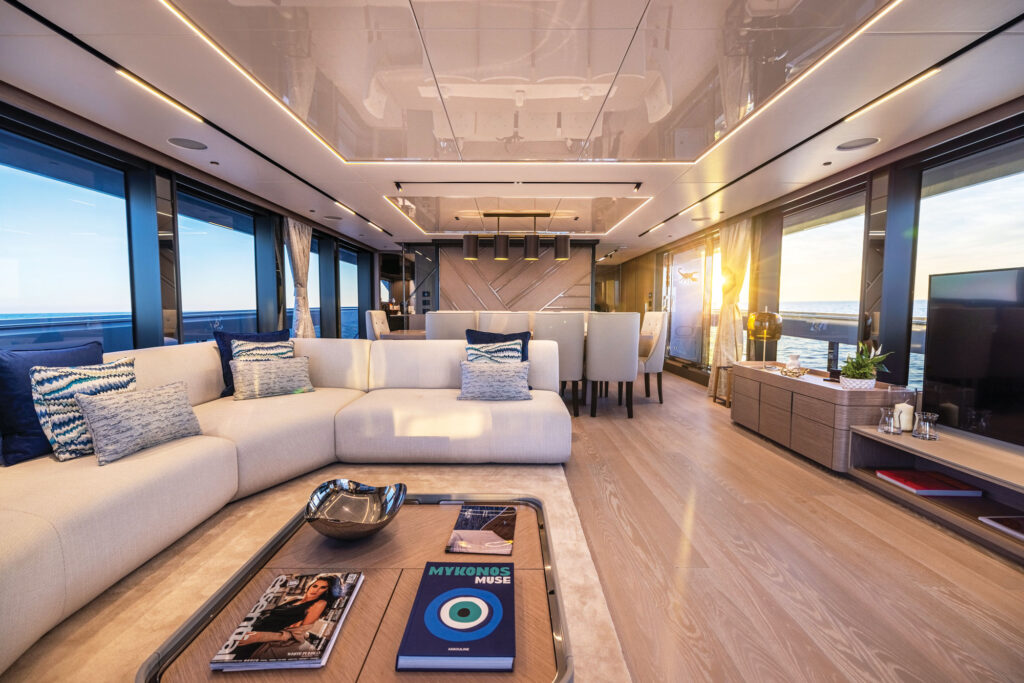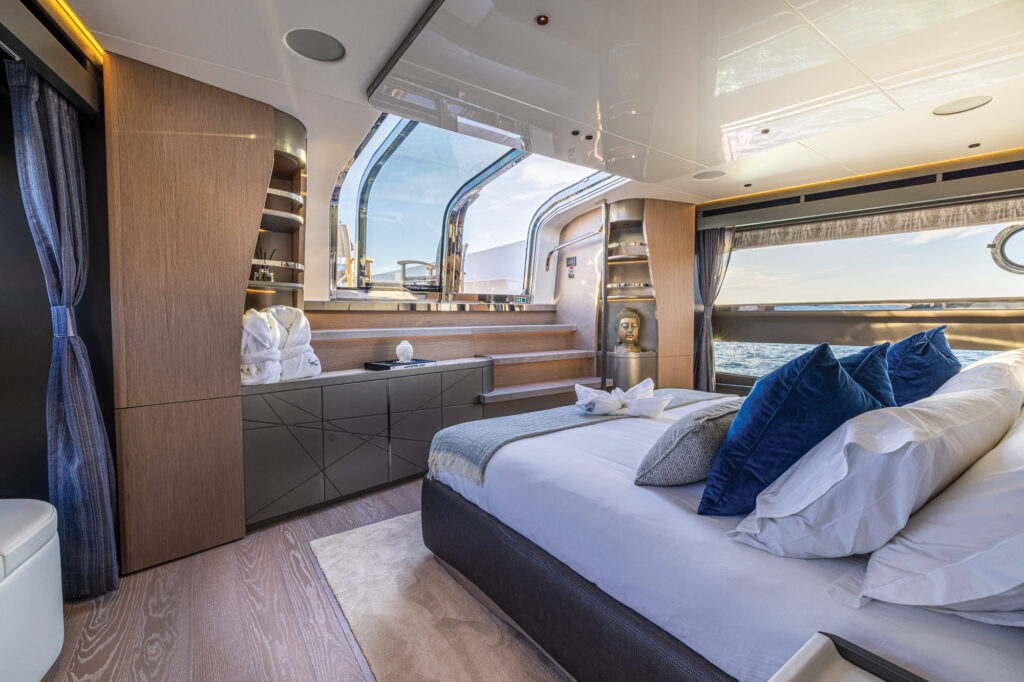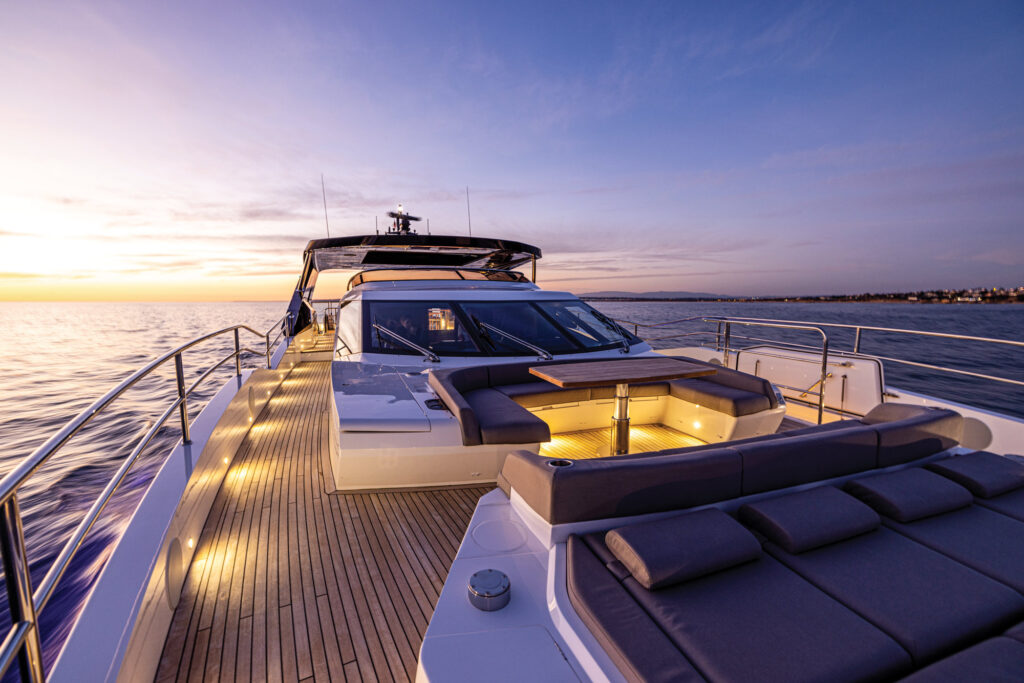
I have always loved navigating after dark. As a youngster, I did it often during offshore racing, yacht deliveries and big summer cruises. I love to see the lights on the water—all the lighthouses, buoys, ships and other boats—and the twinkling distractions ashore. Alas, most of what I do afloat these days is compressed into the hours of daylight, which is why a recent trip aboard a Sunseeker 100 Yacht proved a rare treat.
This particular Sunseeker 100 Yacht had spent the previous 10 days at the Southampton International Boat Show. I went along for the ride to the Sunseeker yard, where the boat would be cleaned and prepped for its owners. This would be a four-hour passage starting around 5 o’clock on a Sunday afternoon. When our lines slipped, it was just shy of high water, which meant we would increasingly get tide help for much of the 60 nautical miles or so that lay ahead.
Our course down Southampton Water was broadly 135 degrees, which we held for around 10 nautical miles before easing around to Calshot Spit. Once into the Solent, we headed west on a ground track of approximately 250 degrees for 20 nautical miles before edging up to 285 degrees for the 23-nautical-mile Poole Bay crossing.
Once across, we headed northwest through the harbor heads and up the narrow 10-knot channel that weaves from the Poole Bar buoy to Sunseeker’s West Quay Road yard. This is where all of the builder’s biggest models are fitted out and commissioned. The latter half of the voyage was in darkness and increasingly wind-over-tide choppy, with a southwesterly whisking up a 4- to 6-foot swell.

The biggest diesels available for this model are twin 2,640 mhp MTU 16V 2000 M96Ls, which should mean a top speed of at least 30 knots. However, our boat had the standard twin MTU 1,920 hp 12V 2000 M96Ls, which delivered close to 25 knots through the water and nearer to 26.5 knots over the ground. At a fast cruise of around 17 knots, with the diesels spinning about 2,000 rpm, the range would be around 415 nautical miles. Slow down to 10 knots and the yacht could run as far as 1,500 nm on full tanks.
Turns are pretty prompt, given the vessel’s half-load bulk of around 220,000 pounds. We kept the CMC Stabilis Electra fins and the Intruder trim system active, and they kept the bow up between 3 to 4 degrees, with roll and pitch nicely in check. Overall, the ride was remarkably comfortable and surprisingly quiet. At full chat, I recorded just 62 decibels at the lower helm with the doors shut, and 57 decibels at a fast cruise. (Normal conversation level is 65 decibels.)
The view from the mostly glazed, raised pilothouse is surprisingly good, especially given the aggressive styling in the windshield’s rake. Instrumentation was on three Simrad touchscreen displays. An L-shaped bench sofa/pilot berth could turn the pilothouse into quite a snug hub on passage.
Sunseeker also offers an upper helm position, and wing or stern stations. With or without that second helm, the upper deck’s layout is asymmetrical. In a first for the yacht builder, the upper deck connects via sloping side decks to the forward terrace’s booth seating and sun pads; farther forward, a foredeck tucks deep into the bow. The foredeck is accessed via a short set of steps to port, while a companionway connects aft from the terrace to the portside deck. The after end of the flybridge is open to a degree of owner interpretation. This Sunseeker 100 had the optional hot tub with flanking sun pads, an oval dining table amidships, and a three-stool wet bar abaft the raised pilothouse steps.

Down in the cockpit area, the transom conceals Sunseeker’s X-Tend sun bed, which opens up as a swim-platform lounger or can lift up to extend the usable space (with balustrades). All of this amounts to a beach-club experience, yet leaves room for a garage that can accommodate a 15-foot jet tender and a PWC.
For an extra bit of luxury, there’s the light, bright main salon. Full-height picture windows along both sides combine with free-standing furniture to create a contemporary, chic vibe. The lounge aft and formal dining forward are a conventional layout. Forward and to port is the galley, with a lobby and day head to starboard.
There is actually three-tier functionality in the hull and superstructure forward of the pilothouse: the foredeck terrace up top; three cabins for five crew with a crew galley; and an owners’ stateroom in between. The owners’ stateroom is accessed via the main-deck lobby to starboard, past walk-in closets and an inviting rain shower en suite. More picture windows flank a forward-facing king berth, and six steps rise to a sliding glass door that connects to the foredeck as the owners’ private retreat.
The lower deck’s layout is conventional, with four en suite staterooms for as many as 10 guests. Two staterooms amidships have king berths, while the other two are forward with berths that can be configured as twins or doubles. They can also have Pullman berths.

After such a pleasant cruise, I wished I could have spent the rest of the evening aboard or, better still, gone to sleep with the excitement of where we would take the Sunseeker 100 Yacht tomorrow.
Pushing the Envelope
It seems like only yesterday that Robert Braithwaite, who founded Sunseeker, walked me proudly through the first-ever Sunseeker to break the 100-foot barrier. It was the Manhattan 105, and the first one belonged to Eddie Jordan of Formula One fame. It was called The Snapper. Overall, 11 of the 105s were delivered between 2000 and 2006. At the time, it felt like a gigantic leap forward for Sunseeker, whose previous flagship, the Manhattan 80/84, had taken the title from the Manhattan 74.
Now, 22 years later, I was aboard the fifth 100 Yacht, with six or seven others already afloat. Since that first Manhattan 105, around 140 Sunseekers from 100 to 155 feet have been delivered.
Historic Shipyard
Sunseeker’s home is in Poole, England, a port north of a well-sheltered but mostly shallow natural harbor on the South Coast. The surrounding area, a UNESCO World Heritage Site, is known as the “Jurassic Coast” because cliffs along its 100-mile coastline are packed with fossils dating back about 200 million years.
Take the next step: sunseeker.com








